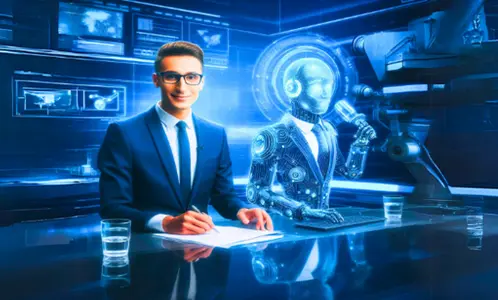In the rapidly evolving landscape of media and journalism, artificial intelligence (AI) has become a pivotal force, particularly in the realm of video journalism. AI news generators are at the forefront of this transformation, offering tools that automate the creation of news content, thereby reshaping how stories are sourced, produced, and delivered.
In this post, we explores the mechanisms of AI news generators, their impact on the field of video journalism, the challenges they pose, and what the future holds for AI-driven news production.
The Advent of AI in Video Journalism
AI news generator tools use advanced algorithms and machine learning techniques to create news stories from data and pre-existing content. These systems are capable of analyzing vast amounts of information, identifying trends, and generating news stories with little to no human intervention. In video journalism, these AI systems are not only writing scripts but also assisting in editing, voice-overs, and even determining the visual content that accompanies stories.
Technological Foundations
The foundation of AI news generators lies in natural language processing (NLP) and machine learning. NLP allows computers to understand and manipulate human language, while machine learning provides these systems with the capability to learn from data patterns and improve over time without human intervention. Together, these technologies enable AI systems to produce coherent and contextually relevant news pieces.
Impact on Video Journalism
The integration of AI news generators has significantly influenced several aspects of video journalism:
Increased Efficiency
AI systems can generate news reports in seconds, which significantly speeds up the news cycle. This rapid content creation allows news outlets to deliver breaking news more quickly and efficiently than traditional methods.
Cost Reduction
AI-driven content creation reduces the need for large production teams, which can be particularly beneficial for smaller news outlets or startups. This democratization of news production allows for more voices and perspectives to be heard without the barrier of high production costs.
Enhanced Personalization
AI algorithms can tailor news content to the preferences of individual viewers. This personalization extends not only to the topics covered but also to the presentation style, including the complexity of the language used and the accompanying visuals.
Global Reach
AI news generators can quickly translate news content into multiple languages, making stories accessible to a global audience. This capability is invaluable in fostering a more informed and connected world.
Challenges and Ethical Considerations
Despite the benefits, the use of AI in video journalism also presents several challenges and ethical concerns:
Accuracy and Bias
One of the primary concerns with AI-generated news is the risk of disseminating inaccurate information or inheriting biases from the training data used by AI models. Ensuring the accuracy of AI-generated content and mitigating bias is crucial for maintaining trust and credibility.
Job Displacement
The automation of news production raises concerns about the displacement of journalists and other media professionals. Balancing the efficiency of AI with the irreplaceable human elements of journalism, such as investigative skills and ethical judgment, is essential.
Deepfakes and Misinformation
The technology underpinning AI news generators can also be used to create deepfakes—highly realistic and potentially deceptive video and audio recordings. The potential for misuse of AI technologies to generate convincing fake news is a significant concern that needs to be addressed.
Case Studies: AI in Action
Several news organizations have already begun to integrate AI into their operations. The Associated Press, for instance, uses AI to automate the generation of financial reports, allowing journalists to focus on more complex stories. Similarly, the BBC has experimented with AI to help research and compile news material, although the final content is still produced by human journalists.
The Future of AI in Video Journalism
Looking ahead, the role of AI in video journalism is poised to expand. Innovations in AI technology will likely lead to more sophisticated news generators capable of handling complex reporting tasks. However, as technology advances, it will be imperative to develop robust ethical guidelines and quality controls to ensure that AI-enhanced journalism serves the public good.
Conclusion
AI news generators are transforming video journalism, making it more efficient, cost-effective, and accessible. While they present significant benefits, these technologies also bring challenges that require careful management.
The future of journalism will likely see a blend of human and machine collaboration, leveraging the strengths of both to inform and engage audiences worldwide. As this field evolves, continuous evaluation and adaptation will be key in leveraging AI to enhance journalistic integrity and effectiveness.


